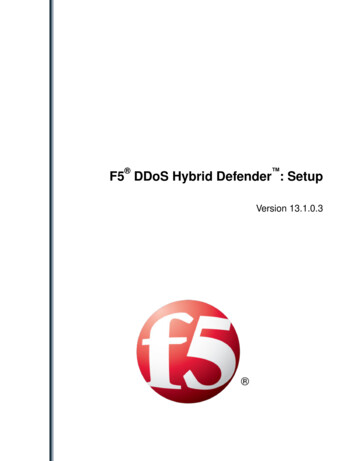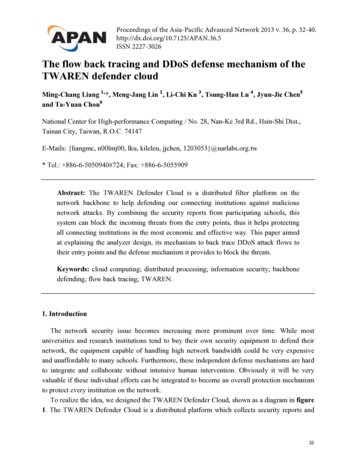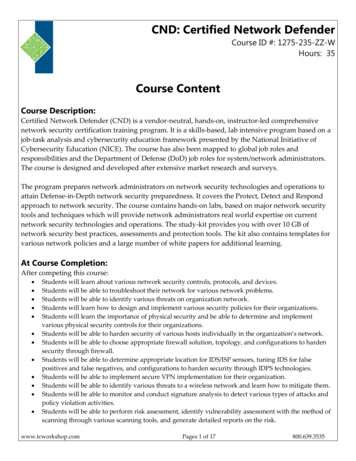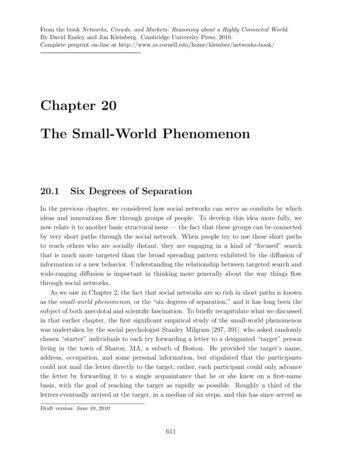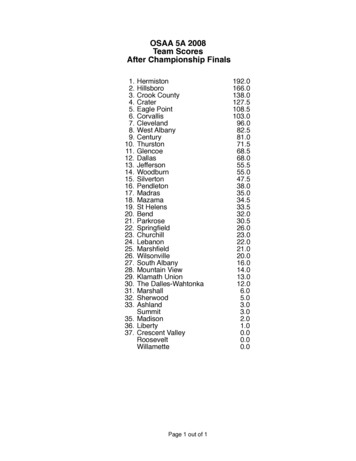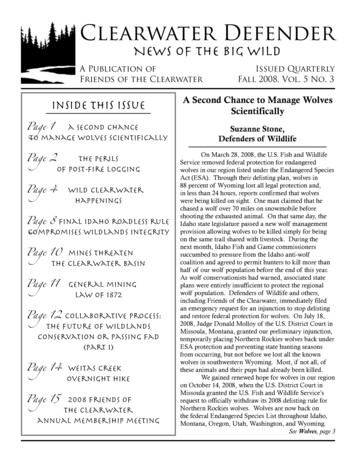
Transcription
Clearwater DefenderNews of the Big WildA Publication ofFriends of the ClearwaterIssued QuarterlyFall 2008, Vol. 5 No. 3Inside This IssueA Second Chance to Manage WolvesScientificallya second chanceto manage wolves scientificallySuzanne Stone,Defenders of Wildlifethe perilsof post-fire loggingOn March 28, 2008, the U.S. Fish and WildlifeService removed federal protection for endangeredwolves in our region listed under the Endangered SpeciesAct (ESA). Through their delisting plan, wolves in88 percent of Wyoming lost all legal protection and,in less than 24 hours, reports confirmed that wolveswere being killed on sight. One man claimed that hechased a wolf over 70 miles on snowmobile beforeshooting the exhausted animal. On that same day, theIdaho state legislature passed a new wolf managementprovision allowing wolves to be killed simply for beingon the same trail shared with livestock. During thenext month, Idaho Fish and Game commissionerssuccumbed to pressure from the Idaho anti-wolfcoalition and agreed to permit hunters to kill more thanhalf of our wolf population before the end of this year.As wolf conservationists had warned, associated stateplans were entirely insufficient to protect the regionalwolf population. Defenders of Wildlife and others,including Friends of the Clearwater, immediately filedan emergency request for an injunction to stop delistingand restore federal protection for wolves. On July 18,2008, Judge Donald Molloy of the U.S. District Court inMissoula, Montana, granted our preliminary injunction,temporarily placing Northern Rockies wolves back underESA protection and preventing state hunting seasonsfrom occurring, but not before we lost all the knownwolves in southwestern Wyoming. Most, if not all, ofthese animals and their pups had already been killed.We gained renewed hope for wolves in our regionon October 14, 2008, when the U.S. District Court inMissoula granted the U.S. Fish and Wildlife Service’srequest to officially withdraw its 2008 delisting rule forNorthern Rockies wolves. Wolves are now back onthe federal Endangered Species List throughout Idaho,Montana, Oregon, Utah, Washington, and Wyoming.See Wolves, page 3Page 1Page 2Page 4wild clearwaterhappeningsPage 8 final idaho roadless rulecompromises wildlands integrityPage 10 mines threatenthe clearwater basinPage 11general mininglaw of 1872Page 12 collaborative process:the future of wildlandsconservation or passing fad(part 1)Page 14 weitas creekPage 15overnight hike2008 friends ofthe clearwaterannual membership meeting
PAGE 2FALL 2008The Perils of Post-Fire LoggingThe U.S. Forest Service Regularly HarmsYour Burned Public LandsDick ArtleyThe vast majority of independent, unbiasedscientists nationwide agree that a post-fire, forestedlandscape is, without a doubt, the most fragile andsensitive to human manipulation. Yet Forest Servicepolicies encourage forest supervisors and rangersto log dead and dying trees from these areas beforethey lose their monetary value at mills. The agencystill emphasizes its misguided, fire suppression-basedSmokey Bear campaign, despite scientific evidence tothe contrary. Although fire is a disturbance in forests,its benefits are lost when humans capitalize on theopportunity to log a burned landscape. The ForestService never mentions this fact in the written materialthat it sends to the public, boasting of the benefits of“mechanically treating the dead and dying trees that arequickly losing their value.”Science Pertaining to “Salvage” LoggingThe most notable scientific paper opposingpost-fire logging is a letter that 546 American biologicalscientists – 72 percent with Ph.D.s – wrote, signed,and sent to Congress on August 1, 2006, in an attemptto head-off legislation that would increase postfire logging on public lands. The legislation neverpassed. The following are excerpts from their letterto Congress, which can be accessed along with thenames and backgrounds of its authors at: /HR4200ScientistsLetter.pdf.When we, as scientists, see policies being developedthat run counter to the lessons of science, we feelcompelled to speak up. Proposed post-disturbancelegislation (specifically, the Forest EmergencyRecovery and Research Act [HR 4200] and the relatedForests for Future Generations Act [S 2079]), craftedas responses to recent fires and other disturbances,are misguided because they distort or ignore recentscientific advances. Under the labels of “recovery”and “restoration,” these bills would speed logging andreplanting after natural disturbances.See Salvage Logging, page 6Printed on 100% post-consumer, recycled paper madewithout using harmful chlorine bleaching agents. Pleasereduce, reuse, and recycle this and all paper products.The Clearwater Defenderis a publication of:Friends of the ClearwaterP.O. Box 9241, Moscow, Idaho .friendsoftheclearwater.orgFriends of the Clearwater, a recognized non-profitorganization since 1987, defends the Idaho ClearwaterBioregion’s wildlands and biodiversity through a ForestWatch program, litigation, grassroots public involvement,outreach, and education. The Wild Clearwater Country,the northern half of central Idaho’s Big Wild, containsmany unprotected roadless areas and wild rivers andprovides crucial habitat for countless, rare, plant andanimal species. Friends of the Clearwater strives toprotect these areas, restore degraded habitats, preserveviable populations of native species, recognize nationaland international wildlife corridors, and bring an endto commodity extraction and industrialization on publiclands.Friends of the Clearwater is a 501(c)(3) nonprofit organization. All contributions to Friends of theClearwater are tax-deductible.The Clearwater Defender welcomes artworkand articles pertaining to the protection of the GreaterSalmon-Selway Ecosystem. Articles in the ClearwaterDefender do not necessarily reflect the views of Friendsof the Clearwater.Board of DirectorsJim Tarter, PresidentTabitha Brown, Vice PresidentChris Norden, SecretaryAshley Martens, TreasurerWill BoydKirstin EidenbachJames HoltJill JohnsonSteve PaulsonFred RabeAdvisory BoardStewart BrandborgJulian MatthewsLarry McLaudChuck PezeshkiStaff MembersEcosystem Defense Director: Gary MacfarlaneEducation and Outreach Director: Helen YostAmeriCorps Member: Sarah AguilarPublicationLayout and Design: Sarah AguilarEditor: Helen YostCopy-Editor: Chris Norden
CLEARWATER DEFENDERWolves, continued from page 1While this legal victory stops the public wolf hunts andindiscriminate killing of wolves in our region for now,the delisting process is now starting over again. Thistime, the U.S. Fish and Wildlife Service should adhereto its original 1994 minimum recovery plan for graywolves in the region, which requires that wolves in eachof the three recovery areas (central Idaho, northwesternMontana, and the Yellowstone ecosystem) be connectedas one “metapopulation.” Packs of wolves need to beable to reach each other in other areas to breed and raisepups without inbreeding. The Service’s own researchproved that, at 2004 population levels that were nearlythree times higher than the recovery goal of 30 breedingpairs, these wolf subgroups were still not connected. Alarger wolf population is clearly needed to ensure thefuture of wolves in the region.Wyoming must also change its law that allowsunregulated wolf killing in nearly 90 percent of the state.The Service firmly rejected Wyoming’s hostile wolfmanagement plan in 2003, then “flip-flopped withoutexplanation” by approving the plan with “the samedeficiencies” in 2007, according to Judge Molloy. Buteach of the states must improve their wolf managementplans to facilitate a sustainable wolf populationthroughout the region that includes our neighboringstates. On the same day this summer, biologistsdocumented a pack of wolves with pups in Washington,and Oregon wolf researchers discovered the state’s firstwolf pack and pups since the species was eradicated inthe 1930s. Biologists are celebrating these finds becausereturning wolves indicate that their ecosystems cansustain greater biodiversity of other native species. Ifwe manage wolves responsibly in Idaho, Montana, andWyoming, we will enable more similar successes inneighboring states.Northern Rockies Wolf (Canis lupus)PAGE 3Make your coffeewith clear waterand coffee roastedin the heart ofwild country!Order a poundof Wild Clearwater Blend coffeeby Landgrove Coffee of Troy, Idaho.10% of proceeds directly benefitFOC work to protectthe Wild Clearwater Country.Contact Friends of the Clearwaterfor ordering information.In the meantime, reinstating federal protectionfor wolves in the region still lets the states managewolves. State agencies can still help livestock ownerswith wolf conflict prevention measures that avoid herdlosses and can still kill wolves that switch to preyingon livestock. Defenders of Wildlife and other groupswill continue to actively work with livestock ownersand agencies to help provide the tools and methods thatreduce losses to wolves and other native carnivores.Ultimately, we would like wolves relieved of their federalprotection and managed by the states in a responsibleand sustainable manner. That process should bringtogether a balance of stakeholders to craft wolf andlivestock management plans based on solid science. AsWesterners who share a deep respect for our naturalresources, we can make this a reality. We have anotheropportunity to get it right this time.(Editor’s note: Please comment before November 28 on theService’s second attempt to delist Northern Rockies wolves.Visit www.friendsoftheclearwater.org/node/619 for moreinformation and a link to the online public comment website.)
PAGE 4Wild Clearwater HappeningsFALL 2008A few years ago, Tim Blixseth of WesternPacific Timber bought the Plum Creek holdings inthe upper Lochsa River watershed. He has purchasedGary Macfarlanecheckerboard lands elsewhere and developed them or,in some instances, traded them to the Forest Service,The last few months have seen importantreceiving great land deals in the process. According toprogress for the protection of wild country in theJ. Robb Brady, editorial writer for the Idaho Falls PostClearwater region. There is much news to report aboutRegister in 1999, corporations like the one Blixseth ownslocal community efforts to safeguard the integrity of ourare “using their clout to influence what happens onnearby national forests and public lands.the public lands. Developers have been buying timberTrading One Problem for Another?company lands in critical areas and then holding theAnyone familiar with the Clearwater NationalForest Service hostage to their threatened development.”Forest knows that the swath of land east of PowellBlixseth recently proposed a land exchange of hisRanger Station encompasses a checkerboard pattern of40,000 acres of heavily clearcut upper Lochsa lands forownership, where each square mile of national forest28,000 acres of Clearwater basin national forests. Theowned by U.S. citizens alternates with a square mile ofClearwater National Forest has posted preliminaryprivate land previously held by Plum Creek Corporation. maps of the swap on their website and will generate anThis arrangement displays the unfortunate legacy of the environmental impact statement (EIS) to explore options,nineteenth century railroad land grants. For a long time, including an alternative wherein the federal governmentconservationists have been interested in consolidatingbuys these private lands. Although these Lochsa tractsthis area into public ownership. As documented in theshould revert to public ownership, the goal of associatedbook Railroads and Clearcuts by Derrick Jensen, Georgeland exchanges should not be to trade one inholding forDraffan, and John Osborn, these lands should haveanother. Some public lands near Elk City identified forrightly been returned to Americans decades ago. Dr.the trade would become more inholdings on the NezJohn Osborn, a well-known Spokane physician andPerce National Forest if exchanged. Friends of theconservationist, has actively campaigned to protectClearwater (FOC) will keep you updated on this issue.Clearwater wildlands from this source of habitatOther Proposalsfragmentation. For more information about the historyAlliance for the Wild Rockies and FOC appealedof checkerboard parcels, visit www.landgrant.org.to the Interior Board of Land Appeals a decision by theBureau of Land Management (BLM) to log in roadlesscountry near Elk City. Although the BLM reduced thesize and scope of the Eastside Township timber sale fromwhat was originally proposed, it approved logging in awildland that could be added to the Selway-BitterrootWilderness by the Northern Rockies EcosystemProtection Act (HR 1975).In an odd but welcome outcome, Nez PerceNational Forest officials and a timber company recentlyterminated their contract for the Meadow Face timbersale. After devising a supplemental EIS, the agencyhad resurrected the sale, which FOC, Idaho SportingCongress, and WildWest Institute (formerly the EcologyCenter) had stopped in court. Forest officers alsowithdrew the Buckhorn Salvage Project near the HellsCanyon Wilderness, after an appeal by Friends of theClearwater and other conservation organizations. Thistimber sale would have logged 180 acres burned by thePoe-Cabin wildfire in 2007. From an ecological andwatershed protection perspective, salvage sales usuallyoccur at the worst possible time to log: after fires.Off-Road Vehicle DamageSee Happenings, page 5on Meadow Creek Trail (Now Closed)
CLEARWATER DEFENDERPAGE 5Happenings, continued from page 4Keeping the Clearwater CleanKamiah resident Ken Jones has led the charge tostop some landfills near his community from pollutingthe watershed. After sharing his information aboutlandfill violations with FOC, he took the issue all theway to Senator Craig’s office, where staff memberJeff Sayre became interested in his concerns. Sayreinitiated a revealing multi-agency meeting in Augustto investigate the situation. Although the expertise ofNez Perce Tribe and Environmental Protection Agencyofficials was evident during meeting discussions,jurisdictional questions among the state of Idaho,federal government, and Nez Perce Tribe have createda vacuum of responsibility for landfill problems.Transactional records also suggest that state agencieshave been negligent in their oversight, approving at leastone landfill site in an environmentally inappropriatelocation. Meeting participants, including Friends of theClearwater, are exploring possible solutions.Motorized MadnessNez Perce National Forest personnel havewithdrawn a decision to upgrade trails in the MeadowCreek roadless area that would have allowed increasedaccess for motorized vehicles. The agency also closedTrail 541 to motorized use. Friends of the Clearwaterhad documented environmental damage from vehicletraffic on the trail (see photo on page 4) and providedthis information to Advocates for the West, who filed alawsuit on behalf the Idaho Conservation League andthe Wilderness Society. FOC was preparing to intervenein the case when the Forest Service closed the trail.Friends of the Clearwater and other conservationorganizations have formally requested the ClearwaterNational Forest to enforce motorized use closuresestablished in sensitive areas by the 1987 ClearwaterNational Forest plan. These closures have never beenimplemented or enforced on the ground. We havebeen monitoring roadless areas and lands vulnerableto motorized use for the last several years to documentproblems with this lack of enforcement. AlthoughClearwater forest officials are finally addressingmotorized use with their upcoming travel plan proposal,it would open many of the sensitive areas now closedto motorized use under the forest plan. The draftenvironmental impact statements for the vehicle plans ofboth the Clearwater and Nez Perce national forests willsoon be available for public comment.For more information about any of theseissues, please visit the FOC website at www.friendsoftheclearwater.org.James Holt Jr. Documenting Illegal Off-Road Vehicle Trails(James Holt Photo)Roadless Rule, continued from page 9Wild backcountry lands in Idaho – in theirunchanged condition – are a natural treasure forIdahoans and all Americans. These quiet, special placesthat make Idaho great belong to all of us who have astrong affinity for their rugged beauty. During times ofrapid change, citizens need to plan ahead to guard wildrefuges where we can escape the noise and crowds ofeveryday life. The proposed Idaho rule rolls back currentprotections of the wildlands we hold dear. We cannotallow the federal government and developers to spoilthese roadless areas.One statewide environmental group, the IdahoConservation League, has indicated that it will acceptthis newest and greatest threat to our wild habitat,while the Wilderness Society has issued statements thatit is displeased with this Forest Service arrangement.Friends of the Clearwater advocates at least maintainingthe existing protections of the 2001 Roadless Ruleand ideally providing permanent protection forbackcountry areas in the region through the NorthernRockies Ecosystem Protection Act (HR 1975). FOC isconsidering our legal options for challenging the finalIdaho rule in the court system – our last remaining hopefor protecting our wild heritage from this rule. If youcan donate resources to this effort, please contact Friendsof the Clearwater staff at foc@friendsoftheclearwater.org or 208-882-9755. For more information about thisimportant issue, see the links provided on the FinalIdaho Roadless Rule FOC web page.
PAGE 6FALL 2008Salvage Logging, continued from page 2Although logging and replanting may seem likereasonable ways to clean up and restore forests afterdisturbances like wildland fires, such activities wouldactually slow the natural recovery of forests, streams,and the creatures within them. Many scientistreviewed studies and syntheses have recently cometo this conclusion. For example, no substantiveevidence supports the idea that fire-adapted forestsmight be improved by logging after a fire. In fact,many carefully conducted studies have concludedjust the opposite. Most plants and animals in theseforests are adapted to periodic fires and other naturaldisturbances. They have a remarkable way ofrecovering – literally rising from the ashes – becausethey have evolved with and even depend upon fire.Wildfire and Salvage Logging, written by Dr.Robert L. Beschta and seven other scientists fromfour universities in the Northwest, the U.S. Fish andWildlife Service, and the Columbia River Inter-TribalFish Commission, is a second important scientific paperopposing post-fire logging. Access this paper at the ire/Beschta-report.htm, with the following excerpts andcitations.Get local perspectiveson conservation issuesfrom your communityradio stationWILDCLEARWATERCOUNTRYRADIO SHOWWednesdays from 4 to 5 p.m.on Radio Free MoscowKRFP 92.5 FMor by streaming audioat www.krfp.orgFragile Area of Selway Burn, 2004Human intervention in the post-fire landscape maysubstantially or completely delay recovery, removethe elements of recovery, or accentuate the damage.Many such adverse consequences are difficult orimpossible to predict or foresee in specific situations.In this light, there is little reason to believe thatpost-fire salvage logging has any positive ecologicalbenefits, particularly for aquatic ecosystems. Thereis considerable evidence that persistent, significant,adverse, environmental impacts are likely to resultfrom salvage logging, based on many past casesof salvage projects plus our growing knowledgeof ecosystem functions and land-aquatic linkages.These impacts include soil compaction and erosion,loss of habitat for cavity nesting species, and loss ofstructurally and functionally important large woodydebris.With respect to the need for management treatmentsafter fires, there is generally no need for urgency, noris there a universal, ecologically-based need to act atall. By acting quickly, we run the risk of creating newproblems before we solve the old ones. Ecologicallyspeaking, fires do not require a rapid human response.We should not talk about a “fire crisis” but rather ofmanaging the landscape with the anticipation thatfire will eventually occur. Given the high degree ofvariability and high uncertainty about the impactsof post-fire responses, a conservative approach iswarranted, particularly on sites susceptible to on-siteerosion.See Salvage Logging, page 7
CLEARWATER DEFENDERSalvage Logging, continued from page 6PAGE 7‘to keep every cog and wheel is the first rule of intelligenttinkering.’ Dead wood, standing and down, is onePost-Fire Logging Degrades Natural Resourcesof those ‘cogs and wheels’.” But Power (2006) warnsAs noted by scores of scientists, logging inthat, “Many of us still see the forest as a warehousepost-fire landscapes degrades soils, causes excessiveof commercially valuable trees to be extracted, not aserosion, delays natural plant and animal succession,a living system that supports us in numerous, other,and introduces or spreads invasive species (Klock 1975,important ways. Until that changes, we will continuePotts 1985, Sexton 1994, Maser 1996, Rumbaitis delto do economically irrational things to our naturalRio 2006, DellaSala et al. 2006). It depletes magnesium landscapes, while imagining that we are pursuingand calcium in the soil (Brais 2000), can be detrimentaleconomic value. That frame of mind unavoidablyto wildlife (Saab 1998), and is not restoration (Nossimpoverishes us.” Apparently, concludes Strittholtet al. 2006). Salvage logging may reduce or eliminate(2005), “It has everything to do with economics for a fewbiological legacies, modify rare post-disturbance habitats, and little or nothing to do with forest health. It is timeinfluence populations, alter community composition,for a real, public debate about post-fire management onimpair natural vegetation recovery, facilitate thepublic lands.”colonization of invasive species, alter soil properties andSolutions for Post-Fire Landscapesnutrient levels, increase erosion, modify hydrologicalOf course, we all use wood-based products andregimes and aquatic ecosystems, and alter patterns ofhavesomelegitimate reasons for cutting green trees onlandscape heterogeneity (Lindenmayer 2006). It can bepubliclandswithout new road construction. However,especially harmful to vegetation: a single post-fire loggingwe must never allow the logging of burned and deadoperation killed 75 percent of established seedlingstrees after a wildfire! Many citizens must wonder why(Roy 1956, Sexton 1998, Donato 2006). Even partialsalvage can severely impact the plants and wildlife most the Forest Service “land managers” continue to logdependent on post-fire landscapes (Hutto 2006). Salvage post-fire landscapes, despite their full knowledge oflogging particularly affects bird species: it may reduce the what unbiased, independent scientists say and writeavailability of tall structures used for bird singing perches about the subject. Unless people are very familiar within post-fire habitats (Wisdom et al. 2000). Black-backed Forest Service culture, they cannot understand howwoodpeckers are very susceptible to the negative aspects important “getting the cut out” is to many Forest Serviceline officers (forest supervisors and rangers). Theirof salvage logging, due to a combination of life historynext promotion dominates these officials’ thoughts andtraits (Thompson et al. 1997). Compared to otherwoodpecker species, they select nest trees with relatively is often best assured by selling our public timber. Theagency revolves around its timber program.small diameters at breast height (Mannan et al. 1980,Forest Service line officers tell the public thatSchreiber and deCalesta 1992, Chambers et al. 1997,theirpost-firetimber sales must be sold soon, because theSaab et al. 2004, Russell et al. 2007), which are usuallywood loses value as it deteriorates. The agency does notthe trees cut most during salvage operations.tell the public that fire-dependent, forested ecosystems,Many scientists assert that, “Natural postfar from wildland-urban interfaces, depend on thefire recovery is generally rapid with no deleteriousconsequences; therefore, active post-fire rehabilitation of massive ecological benefits that fire brings. Humanany kind is usually not needed and may even be counter- manipulation, in the form of roading and logging postfire landscapes, all but eliminates these benefits.productive” (Strittholt 2004). Thomas (1999) believesClearwater and Nez Perce national forest officialsthat, “Forest managers are increasingly aware of themustbylaw advise the public that they are planningsignificance of Aldo Leopold’s admonition that,a timber sale, by posting a notice in the legal section,located in the classified ads, of the newspaper of record,bi-weekly e-mail updateswhich is the Lewiston Morning Tribune for both nationalon the places you care about:forests. To establish standing to appeal a post-fire timbersale, a citizen must provide comments on the sale, in theform of either “scoping” comments early in the processcontact us ator as comments reviewing environmental analyses priorfoc@friendsoftheclearwater.org to a final Forest Service decision. Please speak outwith “subscribe” in the subject line against ANY and ALL post-fire timber sales consideredby either forest.to receive the Big Wild bi-Weekly.Your Public Lands!
PAGE 8FALL 2008Final Idaho Roadless RuleCompromises Wildlands IntegrityOf the 9,304,300 acres of wildlands previouslyprotected by the 2001 Roadless Rule from road buildingand development, the Idaho Roadless Rule immediatelyopens 405,900 acres to extractive uses and roadconstruction. The vast majority of this half a millionRoadless Area Conservationacres of “real estate,” as ex-Appointed-Governor JamesFinal Environmental Impact StatementRisch referred to it during hearings last January, wouldEndangers Roadless Wildlife Habitathost highly toxic phosphate mines in the southeasternpart of the state. Notably, nearly all abandonedphosphate mines in that region are now Superfund sitesSteve Paulsonadministered by the Environmental Protection Agency(EPA) that will continue to emit dangerous carcinogensIn the Federal Register on October 16, 2008,into our human and natural environment for eons andthe U.S. Forest Service published its final rule forcost taxpayers many millions of dollars to clean up.managing the pristine roadless areas within the state ofOnly 1,479,700 acres of the original 9,304,300Idaho (36 CFR Part 294, Special Areas; Roadless Areaacres of Idaho wildlands would retain protectionsConservation; Applicability to the National Forestssimilar to the 2001 Roadless Rule in their new categoryin Idaho; Final Rule). This plan activates substantialof Wild Land Recreation under the Idaho rule. Thischanges in the ways that the agency will manage theseimportant and rare wild areas. With few modifications, final plan would open two-thirds of previouslythe final rule accepts the state of Idaho’s proposal (or the protected, ecologically invaluable wildlands – aboutIdaho Rule) to decrease wildlands protections established 5,312,900 acres – to timber cutting, road building,and, in some circumstances, mining. In the state’sby the 2001 Roadless Rule, a Clinton administrationoutrageous doublespeak, this “real estate” categoryexecutive order. The final Idaho Roadless Rule in theis called Backcountry/Restoration and Backcountry/Federal Register and the final Environmental ImpactCommunity Protection Zone and encompasses many ofStatement (EIS) for “Roadless Area Conservation” canbe downloaded at http://www.roadless.fs.fed.us/idaho. the Clearwater roadless areas. The remaining acreageis available for logging, road construction, and miningshtml.under some admittedly restricted conditions.Many wildland advocates from the Friends ofSee Roadless Rule, page 9the Clearwater (FOC) community turned out in blizzardconditions to testify against the draft EIS of this proposalat Forest Service hearings last January in Orofino.The majority of local testimony in the Clearwater andmost regions of the state supported protection of thelast, few roadless areas and adamantly opposed thisIdaho rule. Most people testified that it would destroywildlands, damage watersheds, endanger rare wildlife,and create toxic mining waste. Although Idahoans couldexpect rejection of their advice and public commentsconservationists of the yearby the Bush administration, the resulting final rule isa further travesty to our natural world. The roadlessDianne and Bill Frenchareas potentially affected by this plan shelter remnantpopulations of our disappearing native wildlife.The final Idaho EIS and rule advances the state’scitizen activists of the yearproposal that assigned each roadless area in Idaho to oneAl Poplawskyof five different categories or “management themes”:Wild Land Recreation, the most protective categoryand Diane Prorakwith 1,479,700 acres, Special Areas of Historic orTribal Significance on 48,600 acres, Primitive includingvolunteer of the year1,722,700 acres, Backcountry/Restoration (BCR) at5,312,900 acres, and General Forest, Rangeland, andSioux WesterveltGrassland, the most at-risk category of 405,900 acres.FOC AWARDSWe Recognize and Thankthe Following Members
CLEARWATER DEFENDERRoadless Rule, continued from page 8PAGE 9Moreover, the Idaho roadless rule-makingprocess has been plagued by precedent-setting use ofAccording to the Federal Register notice, the final laws. Early in the process, the Bush administration askedrule added certain “refinements” to the draft Idaho Rule the Idaho governor to petition the federal governmentthat somewhat augment limitation
wolf population. Defenders of Wildlife and others, including Friends of the Clearwater, immediately filed an emergency request for an injunction to stop delisting and restore federal protection for wolves. On July 18, 2008, Judge Donald Molloy of the U.S. District Court in Missoula, Montana, granted our preliminary injunction,

